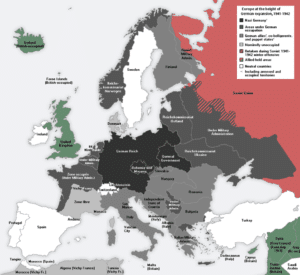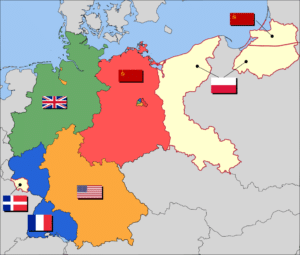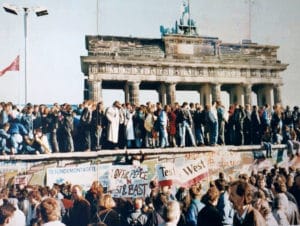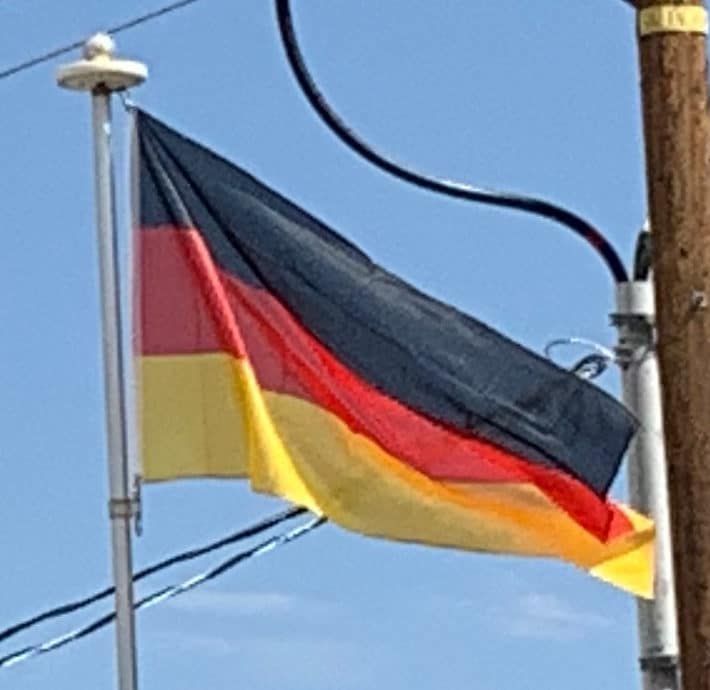
In what later became known as the Holocaust, the German government persecuted minorities, including interning them in concentration and death camps across Europe. In total 17 million were systematically murdered, including 6 million Jews, at least 130,000 Romani, 275,000 persons with disabilities, thousands of Jehovah’s Witnesses, thousands of homosexuals, and hundreds of thousands of political and religious opponents. Nazi policies in German-occupied countries resulted in the deaths of 2.7 million Poles, 1.3 million Ukrainians, 1 million Belarusians and 3.5 million Soviet war prisoners. German military war casualties have been estimated at 5.3 million, and around 900,000 German civilians died. Around 12 million ethnic Germans were expelled from across Eastern Europe, and Germany lost roughly one-quarter of its pre-war territory.
East and West Germany:
After Nazi Germany surrendered, the Allies partitioned Berlin and Germany’s remaining territory into four occupation zones. The western sectors, controlled by France, the United Kingdom, and the United States, were merged on 23 May 1949 to form the Federal Republic of Germany (Bundesrepublik Deutschland (BRD)); on 7 October 1949, the Soviet Zone became the German Democratic Republic (Deutsche Demokratische Republik (DDR)). They were informally known as West Germany and East Germany. East Germany selected East Berlin as its capital, while West Germany chose Bonn as a provisional capital, to emphasise its stance that the two-state solution was temporary.

West Germany was established as a federal parliamentary republic with a “social market economy”. Starting in 1948 West Germany became a major recipient of reconstruction aid under the Marshall Plan. Konrad Adenauer was elected the first Federal Chancellor of Germany in 1949. The country enjoyed prolonged economic growth (Wirtschaftswunder) beginning in the early 1950s. West Germany joined NATO in 1955 and was a founding member of the European Economic Community.
East Germany was an Eastern Bloc state under political and military control by the USSR via occupation forces and the Warsaw Pact. Although East Germany claimed to be a democracy, political power was exercised solely by leading members (Politbüro) of the communist-controlled Socialist Unity Party of Germany, supported by the Stasi, an immense secret service. While East German propaganda was based on the benefits of the GDR’s social programs and the alleged threat of a West German invasion, many of its citizens looked to the West for freedom and prosperity. The Berlin Wall, built in 1961, prevented East German citizens from escaping to West Germany, becoming a symbol of the Cold War.

Tensions between East and West Germany were reduced in the late 1960s by Chancellor Willy Brandt’s Ostpolitik. In 1989, Hungary decided to dismantle the Iron Curtain and open its border with Austria, causing the emigration of thousands of East Germans to West Germany via Hungary and Austria. This had devastating effects on the GDR, where regular mass demonstrations received increasing support. In an effort to help retain East Germany as a state, the East German authorities eased border restrictions, but this actually led to an acceleration of the Wende reform process culminating in the Two Plus Four Treaty under which Germany regained full sovereignty. This permitted German reunification on 3 October 1990, with the accession of the five re-established states of the former GDR. The fall of the Wall in 1989 became a symbol of the Fall of Communism, the Dissolution of the Soviet Union, German Reunification and Die Wende.
Reunified Germany and the European Union:
United Germany is considered the enlarged continuation of West Germany so retained its memberships in international organisations. Based on the Berlin/Bonn Act (1994), Berlin again became the capital of Germany, while Bonn obtained the unique status of a Bundesstadt (federal city) retaining some federal ministries. The relocation of the government was completed in 1999, and modernization of the east German economy was scheduled to last until 2019.
